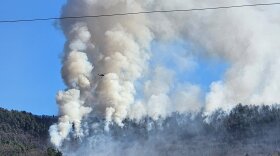While the Butternut Fire was first reported on the evening of November 18th, the official response began in earnest the next day.
“In the early twilight last evening, Great Barrington Fire Department was notified that there may be a wildland fire on East Mountain, which is the range behind us,” said Lee Fire Chief Ryan Brown.
Brown served as the spokesperson for the multi-agency response at its former Great Barrington Fairgrounds headquarters. The struggle to control the fire drew departments from around the region as well as state and federal resources deployed to Great Barrington.
“By 9 o'clock, they had crews on the fire, and they had determined that the safety of the crews was very important because of the dangerous terrain, so they went into an overwatch position, which basically means they observed the fire from a safe distance, making sure that the public and the firefighters were always kept safe," Brown continued. "Early this morning, we started mobilizing local crews for the purpose of fighting this fire.”
That day, WAMC was on the scene to talk to Great Barrington residents anxiously tracking the fire’s expansion.
On Brush Hill Road directly below the billowing smoke atop East Mountain State Forest, Carolyn Stewart watched a phalanx of firefighters marching into the woods.
“I never thought I’d be in this situation," she told WAMC. "In the Berkshires, you feel pretty safe, you don't- All these natural disasters you are hearing about in other parts of the country, you just don't think it's going to happen here. But I don't think any of us are immune. It seems like a whole, entering a new era in that respect.”
Guy Nordoff lives at Bostwick Gardens, a senior apartment complex on the banks of the Housatonic River below the promontory of East Mountain State Forest.
“I was out early this morning, somewhere around 7:30, and I saw this very thick smoke, a big sort of like a smokestack sort of running along the side of East Mountain," he told WAMC. "And I started to get concerned right then.”
In its early days, the fire was an inescapable part of the Southern Berkshire landscape. At night, the highlands burned brightly, and by day, thick smoke enveloped the region while helicopters dumped water onto the fuming ridge.
“I don't think anybody here on this side right now is feeling threatened, but a lot of people seem to be aware of it," said Nordoff. "And if you look across at the mountain, you can see these different sources of smoke. And it's, sort of- those must be, these different spots. And to me, it looks like it could be spreading, but it's kind of hard to tell, because the wind is blowing it around.”
Nordoff was correct.
By that Wednesday, officials announced that the Butternut Fire had expanded tenfold overnight due to the severity of drought conditions in Massachusetts and changes in wind patterns.
“Based on the ground and aerial observations, we believe it is at about 1,146 acres at this time," said Brown. "As you all may well know, the town of Great Barrington declared a state of emergency yesterday. However, it's very important for us to remember at no time has there been a threat to homes or other structures. There is no immediate danger to the residents. There are no plans to recommend evacuations. If that changes, we will communicate that information clearly and well in advance.”
Chief Fire Warden of the Massachusetts Department of Conservation and Recreation Dave Celino reminded reporters that the fire was part of a larger cycle.
“It's a natural effect on the landscape, really," he said. "So, the landscape is burned, but it's not the first time that this landscape is burned, and it's probably not going to be the last time. And so, it's a fire effect on the landscape, and there'll be positive effects that come out of it years down the road in regeneration and natural fire effects.”
By Thursday the 21st, much needed rain fell on Great Barrington. Lieutenant Brian Mead of the Great Barrington Fire Department said the fire had grown to an estimated 1,200 acres and that firebreaks were in place to protect properties being encroached upon by the flames.
“Patrols and alert residents notified us of some fire activity less than a quarter of a mile from homes," said Mead. "That activity was stopped in its tracks. You will see many out-of-town vehicles and apparatus. This reflects mutual aid, state, and federal partners in the statewide fire mobilization plan, which brings resources to support our community.”
With officials confident that the fire’s growth had been blunted, no further in-person press briefings were held.
On Sunday, the Great Barrington FD officially declared the Butternut Fire under control and not expected to grow any further. More than 400 personnel were part of the response to the fire over the course of its outbreak and subsequent containment effort. No property was damaged, and no firefighters were injured. Final numbers peg the size of the fire at around 1,670 acres, over three miles in length, and with a perimeter of over 10 miles. Officials say the cause of the fire is almost certainly human, and that an investigation into its origins is underway between state and local authorities. The area of the fire is still dangerous, and is expected to continue to be a threat until new growth in the spring allows the landscape to regenerate.









